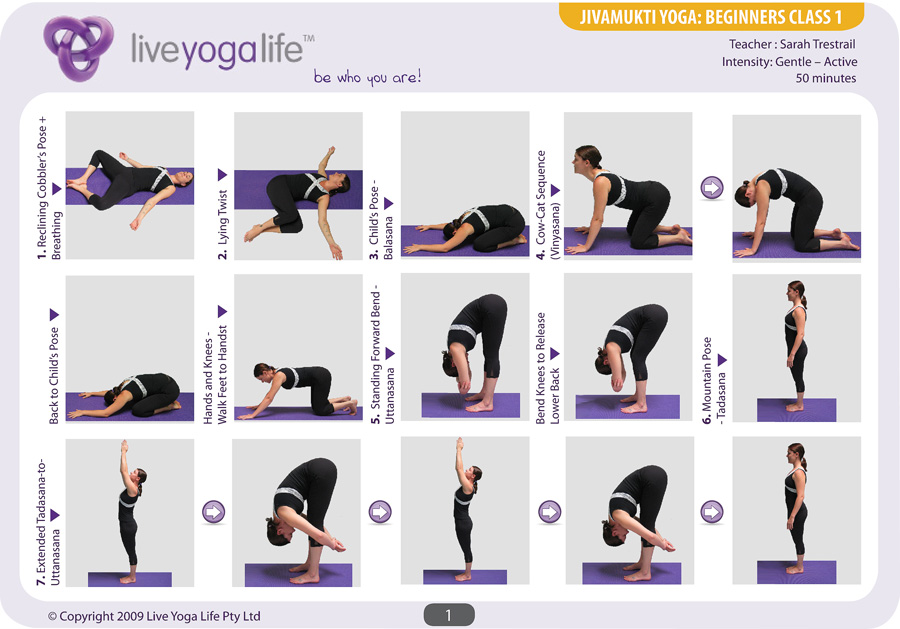
- YOGA SEQUENCE FOR BEGINNERS PDF
- YOGA SEQUENCE FOR BEGINNERS FULL
- YOGA SEQUENCE FOR BEGINNERS DOWNLOAD
Plank pose requires maximum amounts of core strength. Keep your front leg bent, but move your torso so that it is facing sideways and not forward. Your legs stay the same, but the back foot should be shifted so that your heels are aligned. Your arms should go up and your shoulders should stay back. The other foot is flat on the mat and your back leg is lengthened. When doing this pose, one foot goes out in a big step and your leg stays bent. And if you do a lot of exercising with your lower body, this pose can help loosen up your hips and legs. Warrior 1 is essential for building up your core strength. And your hands go upward in a prayer-like motion. Your other foot should slide up your inner thigh or calf. When this pose is practiced the breath needs to be steady. It strengthens many muscles in the legs and improves ankle and thigh strength. Tree pose requires some balance but is fairly easy to practice. You want to lengthen up through your spine. Keep your shoulders down and away from your ears. Your feet can be together or hip-length apart. This is a standing position, but you want to make sure your body is aligned right. Mountain pose is one of the most basic yoga poses. And you want to keep your feet planted and close to your hips. You hold your body in this position for a few breaths. Lie on your back with your arms to your side and your legs bent. Bridge pose can help strengthen your back with repeated practice. Your legs should stay planted to your mat, but your shoulders should be up and your head pointing towards the ceiling. Then you bend your elbows and lift your upper body up. You start by laying on your stomach and putting your arms to your side. Cobra Pose, also known as upward facing dog, in another back stretcher. Really, it's best to do this at the end of your practice so you can cool down. Many people have a hard time holding corpse pose as a result. But you need mental concentration to hold it. It’s a basic kind of position, which doesn’t require a lot of effort. Essentially, all you have to do for this pose is lay on your back, and keep your arms to your side. Corpse pose is pretty simple but entirely relaxing. Basically, you want to keep your back curved like a bow. Keep your head down and your arms straight and hold this pose. You simply get on all fours, and then push your palms down as you round you back. It isn’t hard to do this pose and it gives you back a nice stretch. Cat Pose is another great yoga pose for beginners. Lengthen your arms and legs so you are forming a triangle shape with your body. Then you just tuck your toes and press your palms into your mat, and fully stretch out. Your knees should also be aligned with your hip bones. Make sure your wrists are directly under your shoulders. To do a downward dog, you get on all fours and align your limbs. So you can really strengthen and tone up your body. Downward dog is one of the most well-known yoga poses, and it gives you a great full-body stretch! You use most of the major muscle groups when you get into this pose. YOGA SEQUENCE FOR BEGINNERS DOWNLOAD
Want an easy way to remember the names and poses of 15 of the most common postures? Download our yoga pose cheat sheets you can easily reference in the future.īeginner Yoga Poses to Master 1.
YOGA SEQUENCE FOR BEGINNERS PDF
Free Printable Yoga Poses for Beginners PDF
YOGA SEQUENCE FOR BEGINNERS FULL
This way you can start reaping the full benefits of yoga! Get the free yoga poses printable PDF too. In this blog post, we’ll go over some easy but effective yoga poses. I almost always begin a pose with a block and then move it if/when my body invites me to go deeper.Yoga is the perfect way to stay healthy and get in shape! You might be intimidated by this ancient practice, but there are plenty of postures that beginners can use to get started. You may also want a blanket/towel to sit on during the opening mediation and a pillow or bolster for some of the poses. You may want a block for this beginner yin yoga sequence. In general, more “advanced” yin classes are characterized by longer holds, not “more difficult” or “more advanced” asana. Follow your breath and try not to fidget! If your body invites you to move deeper, then do so, but there is no forcing yourself into a posture in yin yoga.įinally, you hold for time. Once at your comfortable edge, do your best to find stillness. If you ever feel pain, ease out of the pose right away. Your comfortable edge means a point where you feel sensation, but not pain. The three principle tenants of yin yoga are:

Yin yoga focuses on the deeper connective tissues by holding each pose for time. Each class has a comparatively smaller number of poses when compared to a faster, “yang” style class. There are 20 main asana in the Yin Yoga repertoire, but only a handful of these poses are done in each class. Yin yoga is a slower-paced style of yoga.

This post may include affiliate links, which means I may make a commission on purchases made through these links at no additional cost to you.






 0 kommentar(er)
0 kommentar(er)
